By Bill Fulton, Technical Contributor, Automotive Video, Inc.
When I get the intermittent problems in our shop (as well as in my tech hotline calls), the first thing that runs through my mind is, “What subsystem is causing this problem?”
In this article, you’ll notice I’ll be using the term symptom-to-system diagnostic strategies. In other words, if you can identify or verify the symptom, as a technician it’s incumbent upon us to make a diagnostic decision on what subsystem we need to focus on. For example, maybe you’ve got some IPC lights flashing on and off, so you’re obviously thinking it’s a bus circuit issue.
What I’m trying to say is, based on our pragmatic experience over the years, we have to make that initial diagnostic decision based on the symptom and determine from that what system may be causing the problem.
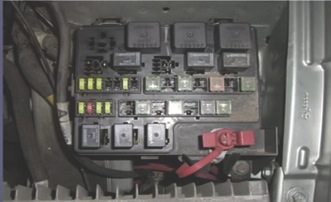
Our Case Study
Our subject vehicle for this Pulling Codes case is a 2004 Dodge Stratus with a 2.7L engine. The symptom is intermittent misfire/idle/stall. The codes I’ve pulled are the random cylinder misfire code P0300, a signal cylinder P0303 and a lean code P0171.
Now here is where we’ll be bringing in those symptom-to-system diagnostic strategies. When we drove the car, we could actually feel it miss and jerk very momentarily. In addition, we have the P0171 Lean Code Bank 1.
You would agree with me that if we really did have a misfire, which we felt, there would have been some un-burnt oxygen molecules seen by the O2 sensor, which may explain the P0171 code. What we’re basically saying here is that the freeze frame told us the P0303 and the P0300 were the primary codes.
The first thing we want to do is be aware of the fact that this is a 2.7L engine with some pattern failures on a timing chain issue. The odometer reads 121,000 miles, so we’d have to be a little bit suspicious of the mechanical integrity of the engine.
This is where we’re going to try to put all of the symptom-to-system separation logic together. We’ve got a misfire code; and we’ve got a concern about the mechanical integrity of the engine.
Some shops may make a mistake and install a cam and crank sensor on it and coils, and COP units, and cam and crank sensors, and injectors, whatever the case may be, and I can assure you, based on my experience with this car, that would not have fixed anything. 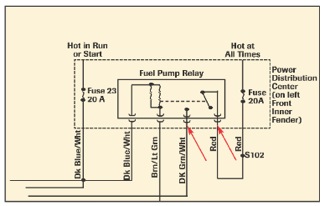
Digging Deeper
Because we’ve got a lean code, let’s go ahead and quickly current ramp the fuel pump. All we have to do is gain access to the fuel pump relay. See Figure 1.
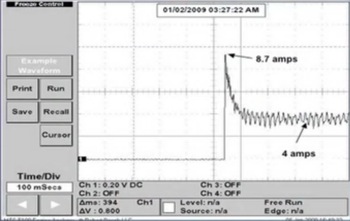 We pop the fuel pump relay out, and put a jumper across the power side of the relay, which is terminals 30 and 87, and we can quickly current ramp the fuel pump. You can see here if you look at my schematic (Figure 2), we’re simply going to take a wire, and we’re going to jumper across the two terminals. It will effectively current ramp the fuel pump. You can see in the schematic that this circuit is hot all the time. In other words, we don’t even need a key on to current ramp this fuel pump.
We pop the fuel pump relay out, and put a jumper across the power side of the relay, which is terminals 30 and 87, and we can quickly current ramp the fuel pump. You can see here if you look at my schematic (Figure 2), we’re simply going to take a wire, and we’re going to jumper across the two terminals. It will effectively current ramp the fuel pump. You can see in the schematic that this circuit is hot all the time. In other words, we don’t even need a key on to current ramp this fuel pump.
Now look at this amperage waveform on the fuel pump (Figure 3). We need to determine the mechanical and electrical integrity of this fuel pump and if its circuit is good or bad.
If you take a look at my scope settings, you can see I’m at 0.20 volts per division, that’s 200 millivolts. The common attenuation factor on amp probes is 100 mV equals 1 amp. Well, in this case, we’re at 200 mV, which would equal 2 amps per division.
At 2 amps per division you can see it peaked at 8.7 amps, which is a good spec on a 4-6 amp pump. That’s the initial current surge. You can also see the pump is online at a very good amperage of 4 amps. So far so good. 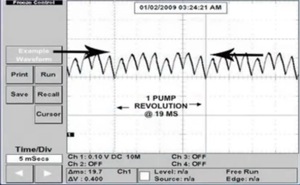
If we look at the waveform characteristics and make sure there’s not too much mechanical slop in the pump bushings, we can determine that we have good electrical integrity between the commentator bars and, of course, the brush contacts.
In Figure 4 we highlighted between the two cursors eight separate segments, meaning the pump turned one revolution, and you can see the cursors indicate 19 milliseconds. If you look at the math here, 1 divided by 19 ms times 60 seconds in a minute, the pump is turning at a very good rpm value for this vehicle.
The pump mechanically and electrically looks good. By the way, on this particular vehicle, there is no Schrader valve, so there’s no access to the rail if you want to do a fuel pressure test. This means we leaned heavily on the amperage waveform on the fuel pump.
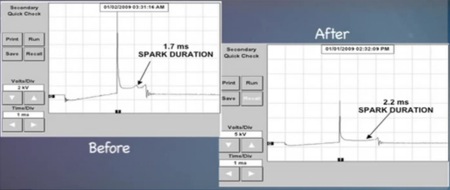 Secondary Spark Check
Secondary Spark Check
Now let’s go after something else. Because we have the misfire codes, let’s do our secondary spark check. I’m using my kV probe, and this being a Chrysler COP-type system, I only have the one air gap.
COP spark duration periods are very long compared to a DI- or EI-type system. On this question of COP, as you can see in Figure 5, when I scope-check secondary on the number 3 cylinder, I only have a 1.7 ms spark duration period, which is inherently short for a COP-type system.
I put a spark plug in and found that they are non-OEM aftermarket spark plugs. I simply called the customer and told him that, for me to go any further, I need to replace the spark plugs with the OEM Champion Iridium spark plugs, and he gave me the OK to do so.
Look at the bottom right-hand side of Figure 5 at my healthy spark duration at 2.2 ms. This is after the spark plugs were replaced.
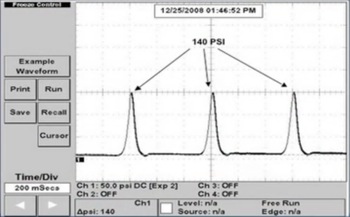 Not Quite Finished
Not Quite Finished
Now do we have the car fixed? We don’t know yet, because remember it was an intermittent problem? We took it for a 10-15-minute test drive and we couldn’t get it to act up. We’re starting to feel pretty good about the repair so far. However, because we had that specific P0303 code, and we have this kind of mileage on this engine, we decided to do a mechanical integrity test of that number 3 cylinder.
Because we have a P0303, I used a pressure transducer and did a wide open throttle cranking compression on number 3. In Figure 6, you can see it shows a very good, consistent 140 psi during wide open throttle cranking.
Let’s take a look at the idle compression. Remember you had 140 psi during cranking. We start the car up now at idle. As you well know, the throttle plates now are closed. We’re in an idle condition. The cylinders are not breathing much air. So inherently speaking, we’re going to have about 30-50% idle compression compared to what we had during cranking. You can see in Figure 7, I again have a healthy 60 psi idle compression. We want to see in this waveform if there’s too much mechanical slop in the timing chain. You can see I brought my cursors in and they tell me the distance between both top dead center (TDC) marks represent 150 ms.
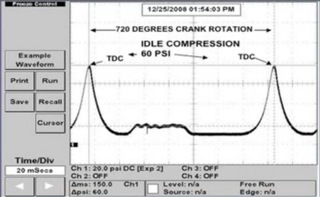 The crankshaft, as you well know, requires two complete revolutions to perform all four strokes. Again, my scope tells me it took 150 ms for the crank to turn two complete revolutions. Here’s how we find out if there’s too much slop in the timing chain. We know that we’re going to open up this exhaust valve very close to bottom dead center (BDC) at the 180° mark. Now I want to take it to 150 ms, and I want to multiply it times 0.25 and whatever that value comes to will actually identify the 180° mark for me. 150 ms x 0.25 comes up to roughly 37 ms.
The crankshaft, as you well know, requires two complete revolutions to perform all four strokes. Again, my scope tells me it took 150 ms for the crank to turn two complete revolutions. Here’s how we find out if there’s too much slop in the timing chain. We know that we’re going to open up this exhaust valve very close to bottom dead center (BDC) at the 180° mark. Now I want to take it to 150 ms, and I want to multiply it times 0.25 and whatever that value comes to will actually identify the 180° mark for me. 150 ms x 0.25 comes up to roughly 37 ms.
I dragged the cursor over to the 37-ms mark and this is BDC of the 180° mark.
Look at my trace in Figure 7. You can see right at the 180° mark there was a pressure shift. That’s indicative of exhaust valve opening, which occurred right there. Again I want to relate that to the 180° cursor.
This is what we’re kind of proud of with the advent of these pressure transducers. If you look closely at my scope pattern in Figure 8, one cursor represents TDC. The other cursor represents BDC. The cam timing spec on this engine says that the exhaust valve should have opened at 54° before BDC. (This is the part we’re kind of proud of.) If you take the time between a TDC mark and that 180° cursor, and count that there are nine minor divisions, 180° divided by nine minor divisions would tell us that the crank turned 20° every minor division. 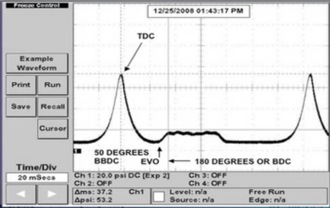
We had a pressure shift that began right at BDC. Now follow closely and you will see that roughly 2-1/2 minor divisions between the EVO point, and that 180° cursor, of 2-1/2 minor divisions, 20° per division, the exhaust valve roughly opened up 50° before BDC.
The timing spec on this engine is 54°. So what does it tell us in summary? We do not have excess timing chain slop that would have caused a sync problem between the crank and a cam, causing maybe the P0300 or, in this case, a P0303 for a number 3 cylinder. This Pulling Codes case is now closed.
For more information on this and other diagnostic strategies, go to www.auto-video.com, and search for the Intermittent Fault Detection Strategies video (LBT-229).
